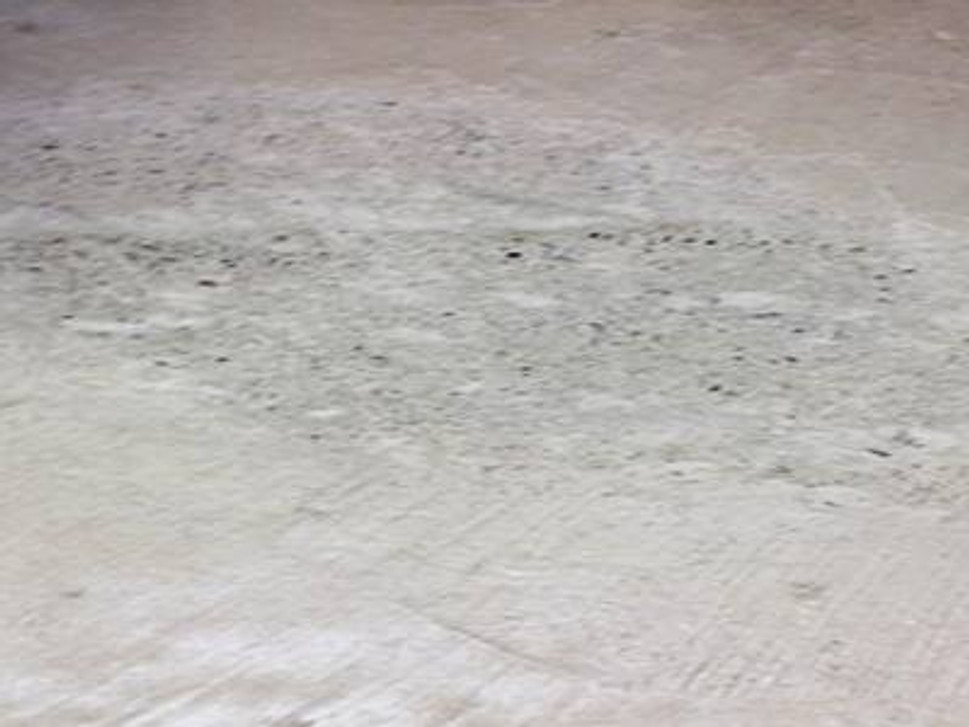Cleaning concrete, bricks, and pavers with an acid (most often referred to as acid etching or acid washing) is a very bad idea and no longer recommended by many coatings manufacturers. It is, however, one of the oldest and most pervasive methods of cleaning concrete used by coatings installers and powerwashers. The most common acids used to clean concrete and bricks are hydrochloric acid (muriatic) or phosphoric acid. For many years it has been the standard cleaning method to prepare concrete for coatings installations, to remove stains of any type from concrete and to remove concrete slurry or efflorescence from bricks. Go to many home stores and ask how to remove stains from your concrete and the answer given most is "Use muriatic acid". Many websites still proclaim that if you wish to put a coating on your concrete surface that the surface needs to be acid etched to insure proper adhesion of the coating.
Acid etching cleans by removing a very thin layer of the surface of the concrete. If the stain is deeper than the surface of the concrete, acid etching will not remove it. It also does not remove previous coatings, oily deposits and other water-insoluble materials. It is also highly unpredictable and unreliable causing the surface to be under- or over-etched and uneven.
The muriatic acid used on concrete and bricks is extremely caustic which means it can burn the skin of the installer. It also has fumes that can burn the lungs. Muriatic acid is a component of hydrochloric acid and can cause great injury and even death to any plants or landscaping that it gets on. If muriatic acid gets on the soil, it may evaporate from the surface but a lot of it stays in the ground, eventually reaching the water supply and killing or injurying wildlife and aquatic plants and animals.
And one of the worst results of using acid is that it destroys the concrete and bricks over the long term, Why? Concrete is very absorbent and is composed of gravel, sand, water and cement. When these four components are mixed together and cured, they form a very hard material called concrete. The concrete has a high alkaline ph value of 12.5 or higher. When it is exposed to an acid etching process, the acid breaks the balance between alkaline pH and the rest of the materials that make concrete hard and weakens the structure of the concrete. Over time the concrete starts to fall apart. You will start to see things like peeling, scaling, pitting, cracking, etc.
The main problem is that as the acid etching chemical absorbs deep into the concrete and it becomes impossible to neutralize the acid all the way. For example, your typical concrete floor is 4 inches thick and when exposed to acid, the acid will penetrate about 3 or more inches deep into the concrete. No matter how many times you neutralize the surface,there will be areas that will not be neutralized. And even worse, there are many people who use acid etching that do not realize that the surface must be neutralized. Any concrete that is not properly neutralized will begin decomposing immediately. It may take time for the damage to reach the surface where you can see it, but it is happening and is usually irrepairable. You can test the surface pH to determine if it has been neutralized but you cannot effectively test the interior of the concrete for pH levels.
It is highly recommended that if you are preparing your concrete floor for a coating, sealing, flooring of any type, or polishing that you do not use acid to etch the concrete. Flooring solutions will eventually fail due to the weakened structure of the concrete from the effects of the acid..
If you need to clean the concrete, they are really only two safe and effective ways to do it. One is using a safe chemical (NOT AN ACID) or two via a mechanical process such as grinding the surface of the concrete.
Both of these methods are very effective for preparing concrete for a new flooring solution. It is best to do some homework as to the best method to use and to find a qualified product or mechanical grinding system for your application of future flooring.
SealGreen has a complete line of safe cleaners and coating removers for a variety of floor applications or to just clean the concrete.
Problem – General concrete cleaner – SealGreen Driveway and Garage Cleaner
Problem – Urine, pet smell, kennel cleaner – SealGreen Kennel Cleaner
Problem – Fresh oil stains – SealGreen Oil Cleaner Degreaser
Problem – Fresh or old oil stains – SealGreen Gray-Out Waterless Oil Cleaner
Problem – Paint, sealer, yellow glue remover – SealGreen SCR1600 Coating Remover
Problem – Black Mastic remover – SealGreen SGR1500 Mastic Remover
Problem – Rust stains from metal – SealGreen Rust Remover
Problem – Prepare floor for paint, epoxy sealer other flooring – SealGreen Color Stain Primer Cleaner
Problem – Mold and mildew – SealGreen Mold and Mildew Remover
Problem – Efflorescence stains – SealGreen Efflorescence Remover

